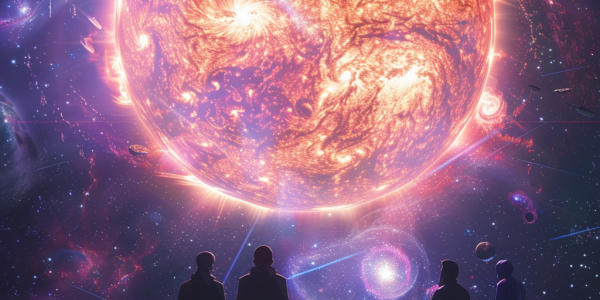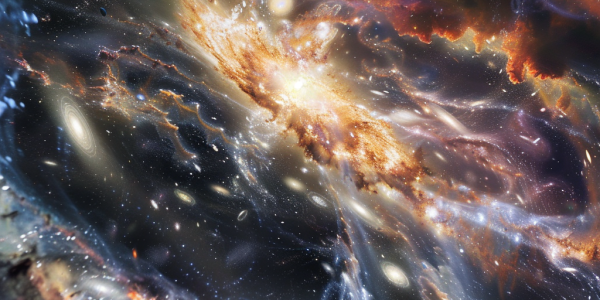NASA’s Webb Telescope Challenges Planet Formation Theories with New Discoveries
NASA’s James Webb Space Telescope has uncovered groundbreaking evidence of protoplanetary disks around ancient stars in the Small Magellanic Cloud, challenging existing theories of planet formation. These findings reveal that disks persist much longer than previously thought, enhancing our understanding of how planets form and the potential for life beyond Earth.
The Night Sky: A Glimpse into the Past
When we gaze at the night sky, we’re not just seeing stars; we’re looking back in time. The universe, approximately 13.6 billion years old, reveals fascinating insights as light from celestial bodies takes years, even millions of years, to reach us. Discover how the light from the sun, moon, and distant stars connects us to the cosmos’ history and the incredible distances involved in this cosmic journey.
Hubble Captures Stunning Image of Interacting Galaxies 390 Million Light-Years Away
NASA’s Hubble Space Telescope captures a stunning image of MCG+05-31-045, a pair of interacting galaxies in the Coma galaxy cluster, 390 million light-years away. This cosmic dance showcases the gravitational interactions that lead to new star formation and the eventual transformation of galaxies into elliptical forms. Discover how these celestial events provide insights into the lifecycle of galaxies and the dynamics of the universe.
James Webb Space Telescope: Ongoing Efforts to Maintain Optical Precision for Cosmic Discoveries
The James Webb Space Telescope (JWST) is redefining cosmic exploration with its advanced optical capabilities and meticulous mirror alignment. Since its launch, a dedicated team has ensured its mirrors remain perfectly aligned, enabling groundbreaking astronomical discoveries. Learn about the ongoing maintenance efforts and the pivotal role of the NIRCam instrument in monitoring JWST’s performance.
Navigating Digital Privacy: Understanding Cookies and Data Management
In today’s digital age, understanding privacy choices is crucial as websites utilize essential and optional cookies for functionality and personalization. A recent study using the James Webb Space Telescope reveals new insights into early black hole formation, emphasizing the intersection of data privacy and scientific discovery.
JWST Findings Challenge Timeline of Universe’s Reionization Epoch
Recent findings from the James Webb Space Telescope challenge established theories on the epoch of reionization, suggesting it may have ended 350 million years earlier than previously thought. This pivotal period, marked by the formation of the first stars and galaxies, plays a crucial role in our understanding of cosmic evolution. Discover how these groundbreaking observations are reshaping our knowledge of the universe’s infancy.
Harnessing the Sun: A Revolutionary Concept for Cosmic Exploration
Scientists are exploring the revolutionary concept of transforming the Sun into a colossal telescope using gravitational lensing, potentially enhancing our ability to observe distant galaxies and celestial phenomena. This innovative approach could lead to groundbreaking discoveries in astronomy while offering a cost-effective alternative to traditional space telescopes. As researchers investigate the feasibility of this idea, the future of cosmic exploration looks promising.
James Webb Space Telescope Discovers Earliest Galaxy, JADES-GS-z14-0
The James Webb Space Telescope (JWST) has made a groundbreaking discovery by identifying JADES-GS-z14-0, the earliest galaxy observed, dating back to just 290 million years after the Big Bang. This remarkable finding challenges existing galaxy formation models, suggesting rapid star formation and raising questions about the evolution of the universe. As researchers explore the implications of this luminous galaxy, the JWST continues to reshape our understanding of cosmic history and the processes that led to the formation of early galaxies.
Dramatic Quasar Interaction Revealed by INAF-Led Research Group
International research group led by INAF used NIRSpec on JWST to observe interaction between quasar and satellite galaxies in distant universe. Unprecedented details shed light on galaxy growth in early universe. Results presented at EAS 2024 meeting in Padua. Discovery impacts cosmic history and galaxies’ evolution.
NASA’s James Webb Space Telescope Discovers Ancient Stars and Massive Black Holes in Young Universe
NASA’s James Webb Space Telescope has made a groundbreaking discovery of ancient stars and massive supermassive black holes in the early universe, challenging existing theories of galaxy evolution and black hole formation. The findings, announced in Astrophysical Journal Letters, reveal objects dating back to 600–800 million years post-Big Bang, with stars hundreds of millions of years old and black holes 100 to 1,000 times larger than the one in our Milky Way.










